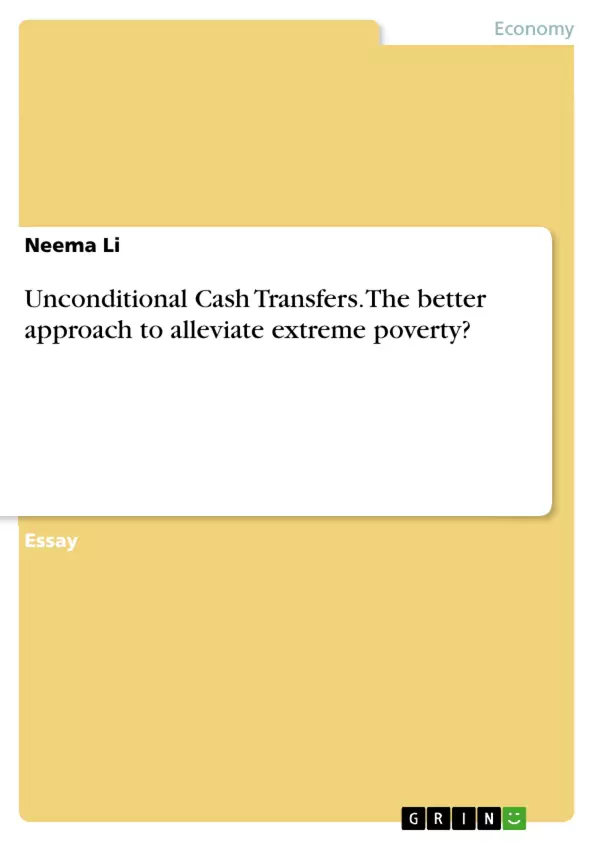This essay aims to investigate the effects of conditional and unconditional cash transfer and its´impacts on alleviating poverty.
Although the number of people living in extreme poverty has declined significantly in recent years, today it still accounts for over 10% of the world’s population living on less than $1.90 a day.
An internationally agreed goal is to reduce this number to zero by 2030 A common approach to bring
people out of poverty and kick-start a virtuous cycle are direct cash transfers .
Conditional cash transfers (CCTs), such as microcredits, as they are granted by the Grameen Bank for almost three decades, have generated considerable hope and enthusiasm for fast poverty reduction. However, in recent years there are increasing numbers
of studies reporting no poverty alleviating effects and even talk about negative impact. The organization GiveDirectly (GD), founded in 2011, pursues a different approach with the allocation of unconditional cash transfers (UCTs).
Inhaltsverzeichnis (Table of Contents)
- Psychological Well-Being
- Empowerment
- Poverty Indicators
- Conclusion
Zielsetzung und Themenschwerpunkte (Objectives and Key Themes)
This essay aims to comparatively analyze the effects of unconditional cash transfers (UCTs) and conditional cash transfers (CCTs) on poverty reduction, focusing on the examples of GiveDirectly and the Grameen Bank. The essay examines the impact of these approaches on psychological well-being, empowerment, and specific poverty indicators such as consumption, assets, and food security.
- Impact of UCTs and CCTs on psychological well-being
- Effects of UCTs and CCTs on empowerment, particularly for women
- Influence of UCTs and CCTs on key poverty indicators like consumption, assets, and food security
- Comparison of the approaches of GiveDirectly and the Grameen Bank
- Evaluation of the effectiveness of UCTs and CCTs in alleviating poverty
Zusammenfassung der Kapitel (Chapter Summaries)
- Psychological Well-Being: This chapter explores the impact of UCTs and CCTs on the mental well-being of recipients. Studies show that UCTs lead to improvements in happiness, life satisfaction, and a reduction in stress and depression. In contrast, microcredits show no or even negative effects on mental well-being, with some studies suggesting a connection between microfinance and suicides among men.
- Empowerment: This chapter examines the effects of UCTs and CCTs on empowerment, particularly for women. UCTs demonstrate a positive effect on female empowerment, characterized by a decrease in domestic violence and a shift away from male-centric attitudes. Conversely, microcredits do not show a significant impact on female empowerment, with several studies indicating a limited influence on women's control over resources and decision-making.
- Poverty Indicators: This chapter analyzes the impact of UCTs and CCTs on various poverty indicators, including consumption, assets, income, and food security. UCTs show significant improvements in these indicators, leading to increased assets, consumption, and revenue, particularly in areas like food security and home improvements. While microcredits have shown some positive outcomes, particularly in the case of productive businesses, they generally do not lead to significant changes in basic development outcomes for poor families. Some studies even suggest that microcredits can lead to a reduction in food consumption as a risk coping strategy.
Schlüsselwörter (Keywords)
The main keywords and focus topics of this essay are unconditional cash transfers (UCTs), conditional cash transfers (CCTs), poverty reduction, psychological well-being, empowerment, consumption, assets, food security, GiveDirectly, Grameen Bank, microfinance, and microcredits. The essay focuses on the comparative analysis of UCTs and CCTs, highlighting the potential of UCTs as a more effective approach to alleviating extreme poverty.
- Citar trabajo
- Neema Li (Autor), 2019, Unconditional Cash Transfers. The better approach to alleviate extreme poverty?, Múnich, GRIN Verlag, https://www.grin.com/document/466607



